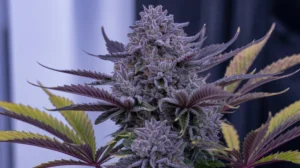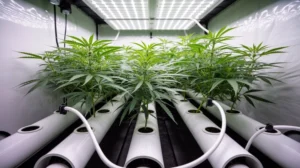Optimizing Temperature Control During Germination

Have you ever wondered why some seeds germinate flawlessly while others never sprout? One of the most critical yet overlooked factors is temperature control during germination.
In this post, we’ll explore how temperature affects germination, the optimal ranges for various seeds, and expert techniques to maintain perfect conditions. Whether you’re starting vegetables, flowers, or cannabis seeds, this guide will help you grow with confidence.
🔑 Key Takeaways
-
Temperature control is essential for successful seed germination.
-
Each seed type has a specific temperature range for sprouting.
-
Tools like heating mats and thermometers help maintain consistency.
-
Monitoring and adjusting temperature boosts germination success.
🌡️ Why Germination Temperature Matters
Seeds need the right conditions to wake up from dormancy and begin growing. Temperature triggers enzymatic activity, water uptake, and root emergence. Without the right heat level, seeds may delay sprouting—or never germinate at all.
What Is the Best Germination Temperature?
Here are the optimal germination temperature ranges for common seeds:
| Seed Type | Ideal Temperature (°F / °C) |
|---|---|
| Lettuce | 55–75°F (13–24°C) |
| Tomato | 70–85°F (21–29°C) |
| Carrot | 50–85°F (10–29°C) |
| Pepper | 70–90°F (21–32°C) |
Matching your seed’s natural preferences gives you faster, healthier seedlings.
🧰 How To Control Temperature During Germination
Maintaining consistent heat is key to avoiding uneven or failed germination. Here’s how you can achieve that:
Recommended Tools and Techniques
-
Heating Mats – Provide steady bottom warmth
-
Soil Thermometers – Help track actual soil temperature near seeds
-
Germination Domes – Trap heat and humidity for a mini greenhouse effect
-
Temperature Controllers – Automatically turn mats on/off to prevent overheating
💡 Pro Tip: Combine tools for greater precision, especially for heat-sensitive seeds.
🌍 Environmental Factors That Affect Germination: Heat
Several conditions can impact how well your seeds respond to heat:
Seed Variety Heat Tolerance
-
Heat-Loving Seeds: Tomatoes, peppers, melons
-
Cool-Loving Seeds: Lettuce, spinach, brassicas
External Conditions
-
Drafty rooms can lower temperatures
-
Humidity levels affect temperature stability
-
Direct sunlight may overheat closed trays
🛠️ Adjust your grow setup accordingly based on season and location.
✔️ Tips for Maintaining the Ideal Germination Temperature
Follow these actionable tips to keep your seeds warm, but not too warm:
1. Use Heating Mats
Place trays on top of seedling heat mats, especially in cool indoor conditions.
2. Monitor Soil Temperature
Use a soil probe thermometer to measure temperature 1–2 inches deep.
3. Adjust Room Temperature
Use a space heater or AC unit to regulate ambient air in your germination area.
4. Provide Proper Ventilation
Good airflow prevents excessive heat and mold. Oscillating fans work well.
5. Follow Seed-Specific Guidelines
Always check seed packets or supplier instructions for precise ranges.
| Control Tip | Benefit |
|---|---|
| Heating mats | Boost sprouting speed |
| Room adjustments | Create ideal growing conditions |
| Thermometers | Keep soil within safe limits |
| Ventilation | Reduce mold and overheating |
| Seed-specific range | Maximizes success rate |
⚠️ How To Overcome Temperature Challenges
Even with the right tools, unexpected issues can arise. Here’s how to handle them:
Fluctuating Temperatures
-
Use thermostat-controlled heat mats
-
Avoid placing trays near cold drafts or heaters
Extreme Outdoor Weather
-
During hot spells, shade trays or bring them inside
-
In winter, insulate trays or use grow tents
Poor Ventilation
-
Use fans or crack windows to improve air exchange
-
Space trays to allow for airflow between them
🌱 Germination Temperature and Seed Viability
Viability refers to a seed’s ability to sprout under the right conditions. Heat plays a big part.
-
Too Cold = Slow or no germination
-
Too Hot = Can kill the embryo inside
Stay within these general ranges to support strong starts:
| Seed Type | Ideal Germination Temp (°F) |
|---|---|
| Tomato | 70–85 |
| Lettuce | 60–70 |
| Carrot | 55–75 |
| Beans | 65–85 |
Check your thermometer daily and make small adjustments as needed.
📊 Monitoring and Adjusting Temperature in Real Time
Use These Monitoring Tools:
-
Digital Soil Thermometers
-
Wi-Fi Temperature Sensors
-
Automatic Controllers with Timers
Make Quick Adjustments:
-
Add a heat mat or remove it if it’s too hot
-
Change tray location based on indoor temps
-
Use reflective insulation to retain warmth
📍 Create a germination log to track temperature readings and sprouting progress.
🧾 Conclusion: Master Germination by Mastering Temperature
Temperature is one of the most important elements in seed germination. Whether you’re growing vegetables, herbs, or cannabis, maintaining the right germination temperature ensures fast, strong, and uniform seedling growth.
Combine heat control with good moisture, proper lighting, and ventilation, and you’ll set your garden or grow operation up for success.
❓Frequently Asked Questions (FAQs)
What temperature do most seeds need to germinate?
Most seeds germinate well between 65°F and 85°F (18°C to 29°C), though it depends on the variety.
Can seeds germinate if it’s too cold?
Cold temperatures slow down or prevent germination. Use heating mats to help maintain ideal warmth.
What happens if it’s too hot?
Excess heat can kill the seed embryo or cause poor sprouting. Use thermometers and controllers to avoid this.
Do different seeds need different temperatures?
Yes. Always check the ideal range for your specific seed type.
Should I monitor soil or air temperature?
Soil temperature is more important for germination—use a soil thermometer for accurate readings.
Want more seed-starting tips?
Check out our guide on how to germinate seeds successfully indoors. While you’re here, don’t forget to shop our collection of cannabis seeds and clones.
Suggested Articles
;)
;)
;)






 15 Dec 2025
15 Dec 2025  9 min read
9 min read


 July 14, 2025
July 14, 2025 


RESPONSES (0)
No responses yet. Be the first to respond!